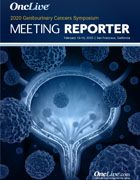Publication
Article
Supplements and Featured Publications
Nivolumab Plus Sitravatinib Highly Active in ccRCC
Author(s):
Combining nivolumab (Opdivo) with sitravatinib induced a confirmed objective response rate of 39% and a 92% clinical benefit rate in patients with advanced clear cell renal cell carcinoma.
Pavlos Msaouel, MD, of the University of Texas MD Anderson Cancer Center

Pavlos Msaouel, MD
Combining nivolumab (Opdivo) with sitravatinib induced a confirmed objective response rate (ORR) of 39% and a 92% clinical benefit rate in patients with advanced clear cell renal cell carcinoma (ccRCC).1
Among 38 evaluable patients, the combination resulted in a median progression-free survival (PFS) of 10.3 months. The clinical activity and preliminary PFS results far exceeded the historical performance of other therapies used to treat ccRCC, Pavlos Msaouel, MD, of the University of Texas MD Anderson Cancer Center, reported at the 2020 Genitourinary Cancers Symposium.
“In this single-arm, phase I/II trial of sitravatinib plus nivolumab…we observed a higher objective response rate and longer progression-free survival than historically reported with single-agent nivolumab or single-agent cabozantinib,” said Msaouel. “The combination has an acceptable toxicity profile, associated with manageable adverse events. The combination of sitravatinib and nivolumab is now being explored in other tumor types.”
Sitravatinib inhibits multiple receptor TKs, including the TAM family, VEGFR2/PDGFR/cKIT family, and c-MET. Inhibiting those targets might enhance antitumor activity by multiple mechanisms, including improved tumor perfusion, depletion of immunosuppressive cell subsets, and increased T-cell priming, said Msaouel.
In a phase Ib trial involving patients with anti-VEGF refractory metastatic ccRCC, single-agent sitravatinib led to objective responses in 8 (25%) of 32 patients and a clinical benefit rate (response plus stable disease) of 94% (30 of 32 patients). Multiple patients had responses and stable disease that lasted beyond 52 weeks.2
Nivolumab has an approved indication for advanced ccRCC and is associated with an ORR of 25% and median PFS of 4.6 months.3 Investigators hypothesized that administration of sitravatinib with nivolumab would augment nivolumab responses in patients with metastatic ccRCC that had progressed on antiangiogenic therapy, said Msaouel.
Eligibility criteria were similar to those in the CheckMate-025 randomized trial comparing nivolumab and everolimus (Afinitor): disease progression on 1 or 1 prior antiangiogenic therapies, measurable disease, and Karnofsky Performance Score (KPS) ≥70. The primary objectives were safety-based dose finding (no dose-limiting toxicity within 12 weeks) and efficacy (no disease progression within 6 weeks).
As of Jan 1, 2020, the trial had accrued 40 patients, all of whom were included in the safety population, as well as 38 in the evaluable efficacy population. Msaouel said 1 patient discontinued treatment prior to the first tumor assessment because of an adverse event and another patient had been followed too briefly for efficacy assessment.
The patient population had a median age of 68, and men accounted for 35 of the 40 patients. All but 6 patients had intermediate-risk disease, and 37 of 40 had KPS scores of 90 to 100. All but 5 patients had a history of nephrectomy, and 32 had no prior radiation therapy.
Five patients had received 2 prior systemic therapies and the rest had received 1. The most commonly used antiangiogenic agents were sunitinib (Sutent, 35%), pazopanib (Votrient, 57.5%), and axitinib (Inlyta, 15%). The median duration of first-line therapy was 10.8 months.
The most frequent adverse events (any grade) were diarrhea (73%, 10% grade ≥3), fatigue (68%, 10%), elevated liver enzymes (ALT, 58%, 5%; AST 43%, 0), increased lipase (50%, 30%), proteinuria (45%, 13%), anorexia (43%, 3%), abdominal pain (35%, 0), elevated amylase (35%, 13%), and nausea (35%, 0). Other grade ≥3 adverse events were hypertension (8%) and 1 case each of elevated serum creatinine, anemia, and other endocrine disorders.
One grade 5 treatment-related adverse event occurred, involving nivolumab-related myasthenia gravis. Four of the 40 patients included in the safety analysis discontinued treatment because of adverse events.
Toxicities necessitated sitravatinib dose reductions in 21 patients, 15 of which occurred within 12 weeks. Three sitravatinib doses were evaluated in the trial (80, 120, and 150 mg), and all 3 patients treated with the 150-mg dose had dose-limiting toxicity within 12 weeks. The most commonly used dose was 120 mg (22 of 40 patients), and 15 received 80 mg.
The efficacy data showed confirmed objective responses in 39% (n = 15) of the 38 efficacy-evaluable patients. One patient had an unconfirmed complete response. Stable disease was the best response for 20 patients. The results compared favorably with historical results for other agents, Msaouel noted: 3% to 5% for everolimus and 17% to 21% for cabozantinib (Cabometyx).
References
- Msaouel P, Thall PF, Yuan Y, et al. A phase I/II trial of sitravatinib (sitra) combined with nivolumab (nivo) in patients (pts) with advanced clear cell renal cell cancer (aCCRCC) that progressed on prior VEGF-targeted therapy. J Clin Oncol. 2020;38(suppl 6; abstr 612). bit.ly/2URLoa6.
- Pant S, Spira AI, Cho BC, et al. Evaluation of the spectrum selective RTK inhibitor sitravatinib in clear cell renal cell carcinoma (ccRCC) refractory to anti-angiogenic therapy (AAT). J Clin Oncol. 2018;36(suppl 15; abstr 4568). doi: 10.1200/JCO.2018.36.15_suppl.4568.
- Motzer RJ, Escudier B, McDermott DF, et al. Nivolumab versus everolimus in advanced renal-cell carcinoma. N Engl J Med. 2015;373(19):1803-1813. doi: 10.1056/NEJMoa1510665.










